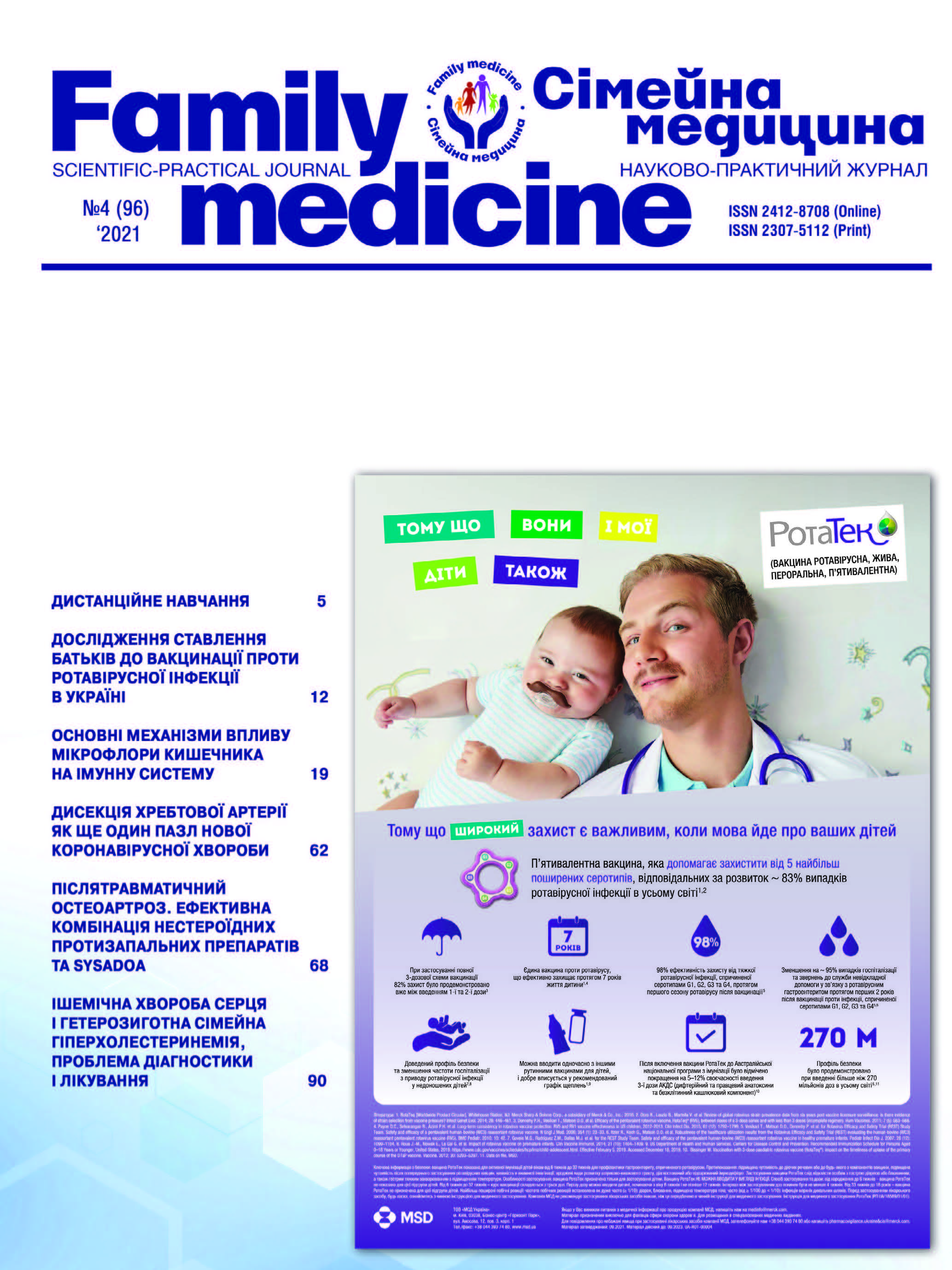Зміни церебральної гемодинаміки та перфузії головного мозку при хворобі моямоя
##plugins.themes.bootstrap3.article.main##
Анотація
.
Хвороба моямоя (ХММ) – хронічне прогресуюче захворювання судин головного мозку невідомої етіології з розвитком критичних стенозів внутрішніх сонних артерій та утворенням патологічної судинної мережі у базальних відділах головного мозку у відповідь на порушення церебральної гемодинаміки, що супроводжується розвитком транзиторних ішемічних атак, інсультів, гематом.
Мета дослідження: вивчення змін показників церебральної гемодинаміки та перфузії головного мозку у пацієнтів із хворобою моямоя.
Матеріали та методи. Проведено ретроспективний аналіз результатів церебральної ангіографії та перфузії головного мозку 6 пацієнтів із хворобою моямоя, які знаходились на лікуванні в ДУ «Інститут нейрохірургії ім. акад. А.П. Ромоданова НАМН України» з 2016 до 2020 рр. Пацієнтам проводили комплексне обстеження, яке включало нейропсихологічне тестування, дуплексне сканування судин голови та шиї, мультиспіральну комп’ютерну томографію (МСКТ), селективну церебральну ангіографію (СЦАГ), МСКТ-ангіографію. Оцінку стану судин моямоя проводили за ангіографічною шкалою Сузуки. Церебральну гемодинаміку досліджували також за допомогою перфузійної МСКТ (ПМСКТ).
Результати. Діагноз хвороби моямоя був підтверджений в усіх пацієнтів за допомогою СЦАГ та МСКТ-ангіографії. Клінічна маніфестація захворювання була представлена ішемічним (n=5; 83,3%) та геморагічним (n=1; 16,7%) інсультами. Ангіографічно було діагностовано Stage 3, Stage 4 і Stage 6 за Сузукі. Зміни перфузії головного мозку були більш значущими при Stage 4 / Stage 6: CBV збільшувалось до 20%, CBF знижувалось >30% із подовженням МТТ (>6 с). Найбільші зміни було виявлено іпсілатерально в басейні СМА, помірні – в басейнах ПМА та ЗМА.
Заключення. Показана відповідність перебудови церебральної ангіоархітектоніки зниженню перфузії головного мозку при хворобі моямоя. ПМСКТ головного мозку дозволяє виявити ділянки з підвищеним ризиком розвитку ішемії та забезпечити вирішальну кількісну оцінку змін церебральної гемодинаміки для встановлення показань до хірургічного лікування.
##plugins.themes.bootstrap3.article.details##

Ця робота ліцензується відповідно до Creative Commons Attribution 4.0 International License.
Автори зберігають авторське право, а також надають журналу право першого опублікування оригінальних наукових статей на умовах ліцензії Creative Commons Attribution 4.0 International License, що дозволяє іншим розповсюджувати роботу з визнанням авторства твору та першої публікації в цьому журналі.
Посилання
Suzuki J., Kodama N. Moyamoya disease – a review. Stroke. 1983;14(1):104–9.
Larson A.S., Lehman V.T., Savastano L.E. Implementation and Rationale for a Unified Clinical and Imaging Protocol for Evaluation and Treatment of Moyamoya Angiopathy: A Single Institutional Experience. Frontiers in neurology. 2021;12:662393.
Yamamoto S., Kashiwazaki D., Uchino H. Clinical and Radiological Features of Childhood Onset Adult Moyamoya Disease: Implication for Hemorrhagic Stroke. Neurologia medico-chirurgica. 2020;60(7):360–67.
Karakama J., Nariai T., Hara S. Unique Angiographic Appearances of Moyamoya Disease Detected with 3-Dimensional Rotational Digital Subtraction Angiography Imaging Showing the Hemodynamic Status. Journal of stroke and cerebrovascular diseases: the official journal of National Stroke Association. 2018;27(8):2147–57.
Shi Z., Ma G., Zhang D. Haemodynamic analysis of adult patients with moyamoya disease: CT perfusion and DSA gradings. Stroke and vascular neurology. 2021;6(1):41–47.
Yin H., Liu X., Zhang D. A Novel Staging System to Evaluate Cerebral Hypoperfusion in Patients With Moyamoya Disease. Stroke. 2018;49(12):2837–843.
Research Committee on the Pathology and Treatment of Spontaneous Occlusion of the Circle of Willis, & Health Labour Sciences Research Grant for Research on Measures for Infractable Diseases. Guidelines for diagnosis and treatment of moyamoya disease (spontaneous occlusion of the circle of Willis). Neurologia medico-chirurgica. 2012;52(5):245–66.
Suzuki J., Takaku A. Cerebrovascular «moyamoya» disease. Disease showing abnormal net-like vessels in base of brain. Archives of neurology. 1969;20(3):288–99.
Hervé D., Ibos-Augé N., Calvière L. Predictors of clinical or cerebral lesion progression in adult moyamoya angiopathy. Neurology. 2019;93(4):e388–e397.
Kim J.E., Jeon J.S. An update on the diagnosis and treatment of adult Moyamoya disease taking into consideration controversial issues. Neurological research. 2014;36(5):407–16.
Shang S., Zhou D., Ya J. Progress in moyamoya disease. Neurosurgical review. 2020;43(2):371–82.
Gibbs J.M., Wise R.J., Leenders K.L., Jones T. Evaluation of cerebral perfusion reserve in patients with carotid-artery occlusion. Lancet (London, England). 1984;1(8372):310–14.
Togao O., Mihara F., Yoshiura T. Cerebral hemodynamics in Moyamoya disease: correlation between perfusionweighted MR imaging and cerebral angiography. AJNR. American journal of neuroradiology. 2006; 27(2):391–7.
Piao R., Oku N., Kitagawa K. Cerebral hemodynamics and metabolism in adult moyamoya disease: comparison of angiographic collateral circulation. Annals of nuclear medicine. 2004;18(2):115–21.





